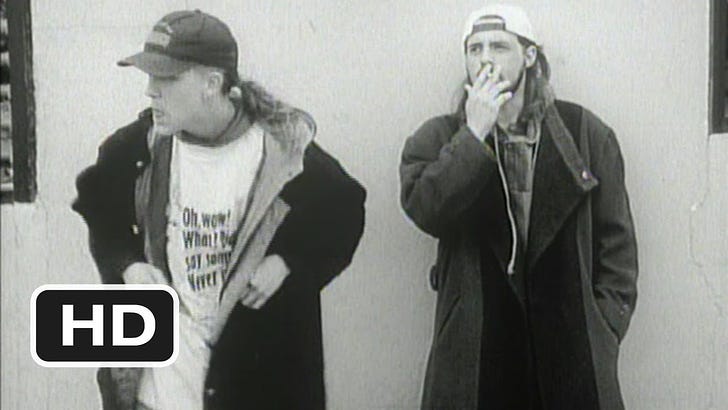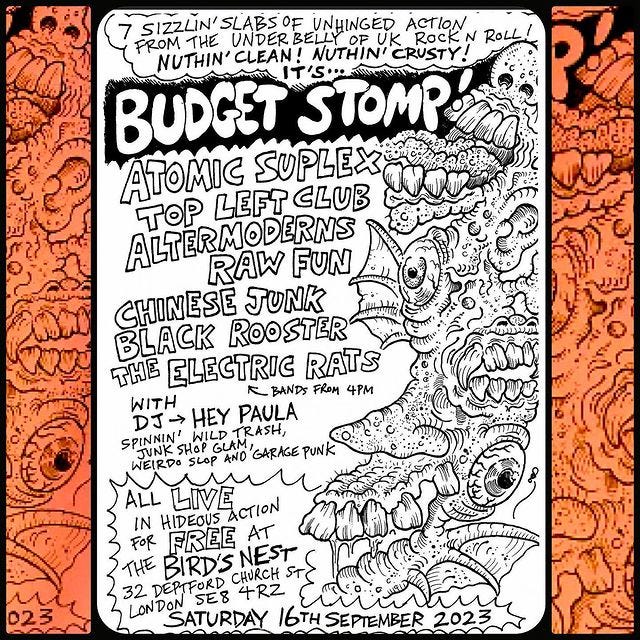THURSDAY THOUGHTS: What Happened To The 'Indie' Aesthetic?
Why so much modern content is missing the human touch.
I’m on the road in Manila right now but last week I wrote about ‘90s cult classic ‘Office Space’ so this week I thought I would repost another piece about ‘90s indie culture and the missing human touch on modern, independent productions. I hope you like. Nx
A couple months back an acquaintance of mine, a tattoo artist named Ben Nuthink, posted a flyer for his band's next gig on Instagram. I follow a bunch of bands on Instagram but his jumped out at me because of that rarest of modern qualities - it was hand drawn.
Ben's a punk. He played bass in semi-legendary Orpington outfit 'The Griswalds' and now plays in 'Chinese Junk'. His artwork reminded me of the great history of hand drawn and photo copied art in punk and indie culture. Seeing it sent a surge of nostalgia through my nervous system. It made me happy to see something so lo-fi drawn with love on the back of whatever medium was nearest to hand. And it made me realise that the age of desktop publishing and digital media has brought that to and end. I miss it, but not purely for nostalgic reasons. Let me explain...
There was time when professional grade design and printing tools, recording equipment and filmmaking gear were so out of reach of most writers, musicians and filmmakers that instead of aspiring to it, they simply ignored it and leaned in to what they had. This produced a look and feel, tone and attitude that was as unique and as identifiable as genre tropes in Westerns or melodramas. In fact 'indie' was a genre. You could go to the indie racks at HMV where a broad range of bands would be stacked together purely on the basis that they had no budget. They didn't sound like U2 or Elton John because they couldn't afford to and this produced a much more diverse range of sounds and styles that people who don't enjoy the over-produced polish of pop or popcorn movies loved. People like me.
For instance, last night I found myself on Mubi watching an early Duplass Brothers movie starring a very young Greta Gerwig (who went on to direct the billion dollar smash hit of the summer 'Barbie'). This film was made on a shoestring in 2008 and is amongst the last of its kind. Shot on digital with, apparently, a single zoom lens and one giant light it's about four actors who try to jump start their careers by retiring to a cabin in the woods to write a film. So that's four actors, one location and a digital camera. And it looks great. There's no gimbals or stabilisers so the camera is constantly jerking around. There's no time for multiple camera and lighting set-ups so, if you need a close up, just zoom in. Music? You don't need much, a few guitar licks dropped sparingly over the spooky moments will create the right sense of dread. (Read a detailed ‘making of’ here: https://www.filmindependent.org/blog/case-study-baghead-2/).
It's so simple, so charming and, in its way, so aspirational because you watch and think, “Yeah, I could that.". It reminds me of 90s classics like Richard Linklater's 'Slacker', which had no plot, no main character, just a bunch of odd, disconnected stories shot on 16mm. But Slacker famously inspired Kevin Smith who saw it and thought, "Yeah, I really could do that!" So, he borrowed US$25k on five credit cards and made 'Clerks' in black and white because he couldn't afford to process colour film. Clerks is now rightly considered an indie classic and is one of my favourite movies of all time.
But it's not just films, music too had a gritty quality born of recording on old four and eight tracks using second hand tape in poorly insulated garages. That's what gives early grunge and indie its unmistakably "grungy" sound. It's the sound of a time and place and a technology necessitated by a lack of budget and no access to pro tools (which, ironically, is now the name of the standard industry software used by EVERYBODY, 'Pro Tools').
These days, as someone who likes to create in all sorts of mediums, I find myself searching YouTube for tutorials but increasingly coming across videos with titles like, ‘How to get a cinematic look out of your iPhone’, or, ‘How to make beats like Kanye’, or, ‘How to design layouts like Taschen’ and it's hard to resist, because the amateurs and the professionals - we've all got the same stuff now. I have to admit there is a massive upside to this; it has created a whole new industry for freelance creatives who can now compete with big agencies for hi-spec work. But it does kinda mean everything looks and sounds the same, with the same flawless polish as mainstream media. And here's the rub, it's the flaws that make it interesting. David Bowie knew that, which is why he refused to ever sing more than three takes of a vocal (unlike Billie Eilish who splices over 100 takes together to make her final vocal track - can't knock her though, at least she’s original.)
I have railed before (and will do so again no doubt), about the fact that data is causing companies, including publishers, record labels and movies studios, to converge on what works rather than what's unique, different or interesting. But the same is true for creators who are no longer nurtured by those companies but must first build their own audiences online to capture their attention. The quickest way to do that seems to be to jump on trends whether that means every influencer doing the same inane TikTok dance or every metal band using the same, perfect guitar tone:
In the half-century between World War II and 9/11 no one really knew what made a hit single or a blockbuster movie but the thinking was that you had to be unique and original, not the same. That's been upended now and everyone is trying to make everything look and sound "professional". But since when was professional the aspiration of art?





